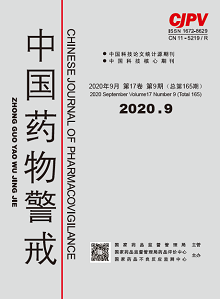|
|
Influence of Community Pharmaceutical Care Service Led by Clinical Pharmacists on Construction and Evaluation of Service Systems for Medication of Elderly Patients with Statins
LAN Xiaohong, ZHOU Yonggang, Zang Juxiang, WU Dongni, LI Xiang, XU Rui, CHEN Shudong, YU Hao ZHANG Ye
2020, 17(9):
594-599.
DOI: 10.19803/j.1672-8629.2020.09.11
Objective To study the influence of clinical pharmacists' participation in community pharmaceutical care on the safety, effectiveness, expense, applicability, compliance and quality of life among elderly patients treated with statins and the influence of the community pharmaceutical service mode led by clinical pharmacists on the rationality of potential drug use among elderly patients in a community. Methods One hundred and sixty-one elderly patients with indications of statins were divided into the control group (n=81) and pharmacist-led group (n=80). The safety, effectiveness, expense and applicability of treatment with statins as well as compliance and quality of life of elderly patients were assessed from different perspectives and by related standards. Results In the safety indexes, the incidence of ADRs, repeated use, interactions, PIM and improper storage of drugs decreased from 28%, 4.2%, 4.9%, 15.3% and 45% to 13%, 2.0%, 1.3%, 2.1% and 26.3% respectively (P< 0.001). However, there was no significant change in the control group after the intervention. In the effectiveness indexes, the proportion of low compliance, lack of belief, poor knowledge and EQ-VAS decreased from 23.8%, 55%, 51.8%, 84.2±12.3 to 13.8 (P >0.05), 34.8 (P <0.05), 21.1 (P<0.05), 77.2±11.4 (P <0.05) respectively. In the past three months, the rate of hospital visits increased from 21.5% to 40.8% (P<0.001), but the mean value of EQ-5D did not change significantly (P >0.05). As for the economic indicators, the average number of medical insurance drugs, the average amount of drugs used and the average monthly drug cost decreased from 5.6%, 27.2 and 8.9% to 3.4%, 17.3% and 4.3% (P<0.05) respectively. In terms of the appropriateness indexes, there was no significant change in the usage of drugs with or without indications(P >0.05).The rate of insufficient dosage and improper treatment decreased from 27.2% and 8.9% to 17.3 and 4.3% (P <0.05) respectively. In EQ-5D indexes, the percentage of anxiety and depression decreased from 25.3% to 20.8% (P <0.05). Conclusion The community pharmaceutical care led by clinical pharmacists can significantly improve the safety, effectiveness, cost-effectiveness and validity of medication for elderly patients. Besides, this approach can enhance the social status and acceptance of clinical pharmacists while providing data for decision-makers to formulate laws and regulations.
References |
Related Articles |
Metrics
|

